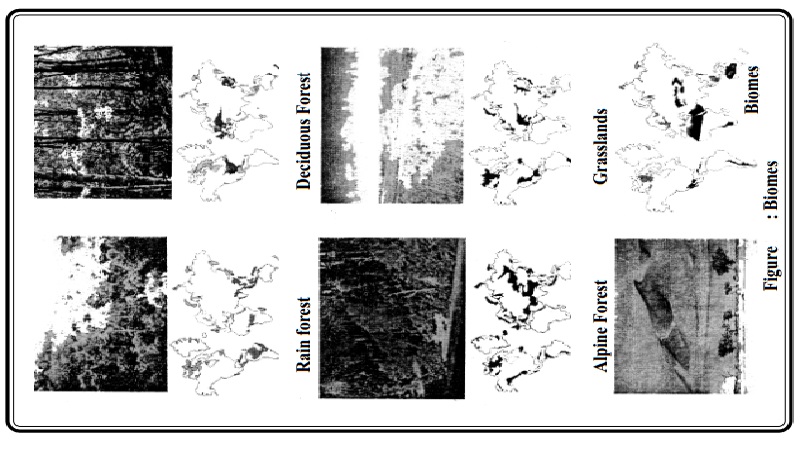Chapter: 11th 12th std standard Geography earth space Higher secondary school College Notes
The forest biomes : Coniferous, Temperate, Tropical forests

Plants and Animals,
The Biomes
The plant and animal
communities of the biosphere living in a particular territory is called the 'biomes'.
These biomes
adapt themselves to the prevailing environmental conditions of the
surroundings. The biomes help us with a clear understanding that we require of
the relationships among the ecosystems. Let us now see the interactions and
relationships among the climate, soil, vegetation, animals and humankind. Based
on their structural characteristics, the biomes can be classified, as follows:
-
1.
FOREST BIOMES
a.
Coniferous forests
c.
Tropical forests
2.
GRASSLAND BIOMES
a.
Temperate grasslands
b.Tropical grasslands
3.
DESERT BIOMES
a.
Cold deserts
b.Tropical deserts
4.
MOUNTAIN BIOMES
THE FOREST BIOMES
Coniferous Forest
Biome: Taiga is the coniferous forest biome lying next to the Tundra regions of
the northern hemisphere. This biome is seen extended across North America and
Eurasia, in a wide belt. Short summers and long winters characterise this biome
region. Conducive temperatures for the growth of plants are found in a stretch
of 4 to 5 months only. In summer, there is little rain. There are the highly
acidic podsol soils, in this region.
Pyramidal trees with needle like leaves are a special feature of this
biome. Immense colonies of same species are commonly found here. As there is
plenty of food and protection, the biome is rich in flora and fauna. Karibu and
Rodents are in abundance. Foxes
and Minsks are bred and brought up by the people. Woodpeckers and
Grosbeaks are the birds that live hereabout.
The birds migrate from the southern regions and live here in the spring
and leave here only in winter. However, the animals have the furs that could
stand severe cold. The Red Cross Bill that lives here has a strong beak that
could break the hardest of the nuts to get at the kernel. In the severe
climatic conditions here, humans are unable to live naturally. Further, this
region is far away from the other regions of the world. Therefore, a vast
expanse of several thousands of square kilometres remain uninhabited. The
tribes here have hunting and fishing as the most important activities.
Temperate, Deciduous
Forest Biome: This biome is found along the western and the eastern continental margins of the mid
latitudes. This biome is found in both the hemispheres. However, it is seen in
a vast area in the northern hemisphere. It is in areas such as those of the
eastern United States, southern Chile, southeast Australia, Tasmania and New
Zealand. Here, the winter is mildly warmer and the summer is mildly hot. The
annual rainfall is regular and high. It is here the brownish forest soils are
found.
In the forests here, the trees grow tall. They shed their leaves in the
months of January and February. It is for this reason, the forests here are
known as the deciduous forests. The Oak, the Maple and the Peach that grow here
have broad leaves and thick stems. In the European regions, the deer, bears,
oxen, wolves, foxes, pigs and wild cats besides other small animals are seen.
In the American deciduous forests, there live deer, bear, panther, red fox and
squirrel. These animals, to avoid the cold during the winter, go into
hibernation. Therefore, they gather food and store them for the winter much
before the cold begins.
The deciduous forests are not as widespread in
the southern hemisphere as they are in the northern hemisphere. In the forests
of Chile, the Peaches are the dominant. In Australia and New Zealand, there are
unique plants and animals.
Except for the forests of the Mediterranean, the other forest biomes of
this variety elsewhere are being changed much by the humans. In Eurasia, this
biome is the target for human settlements. The prevalent environment here is
conducive to human life and living. Therefore, a large number of people live
here. They are engaged in fishing, mining, timbering and industrial activities.
In recent times, these areas have been occupied by the humans and have been
converted into settlements and dairy farms.
Tropical Biome: This includes the rain forests of the equatorial region and the tropical deciduous forests. The tropical rain
forests are found in the Amazon and the Congo valleys, East Indies, India and
Myanmar. In the equatorial regions of high temperature and high rains, there is
profuse tree growth. These supply oxygen to the atmosphere in large quantities.
In these forests, there are trees, bushy plants, creepers, parasites and
epiphytes and hundreds of thousands of other species.
The vegetation is organised in ways suitable to high temperature and
heavy rainfall of the region. To get at the sunshine, the trees grow tall. To
help with high evapotranspiration, the leaves are broad and with wider pores.
The stems of the trees are propped up by the aerial roots.
As the tropical rain forests are thick, there are marshes. The reptiles
and the other animals show characteristics typical of the environments. And as
it is difficult to move about through the thick forests, large animals live at
the edges of these forests. In the thick forests, there are innumerable insects
and furless animals. Further, they live on the leaves and fruits of the
forests. For example, the gorillas and the monkeys and the leopard that live on
these are found in the mangroves.
In the islands of Malaysia and the Philippines
of the East Indies, these forests have been cleared and plantation crops are
grown. Rubber in Malaysia and cocoa in Africa and South America are grown in
these areas.
Related Topics